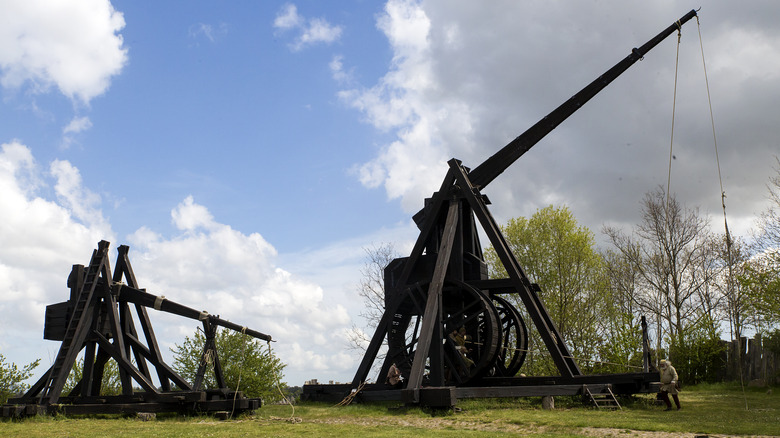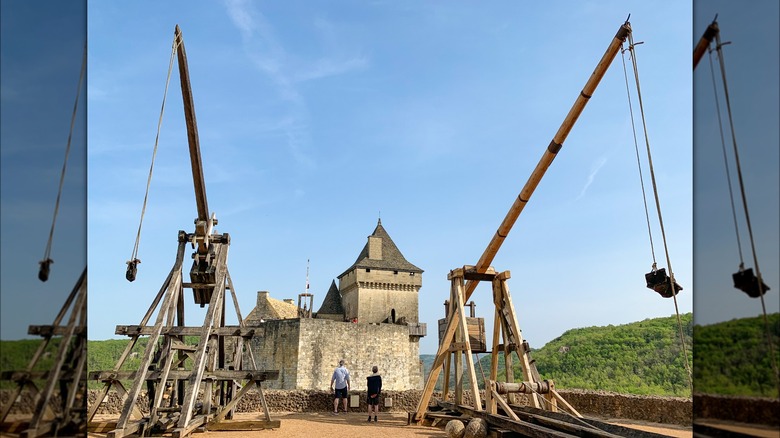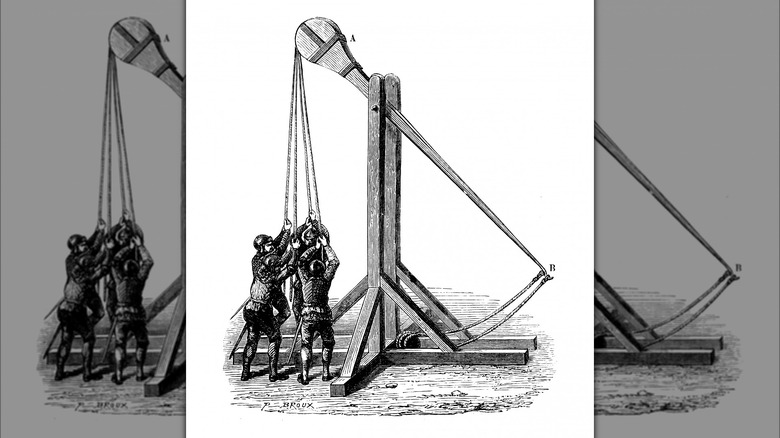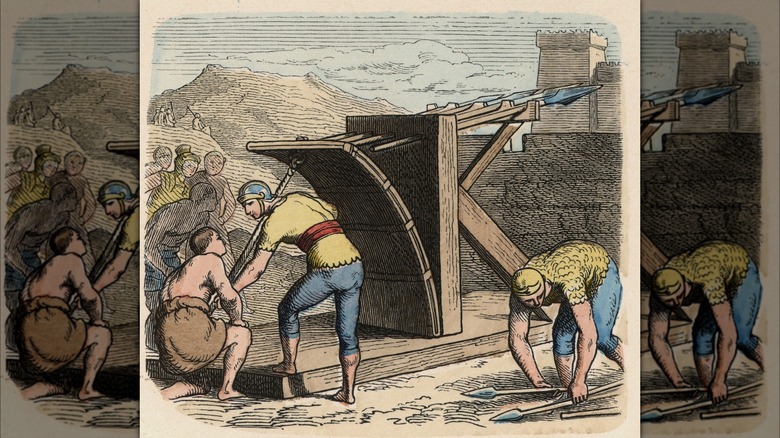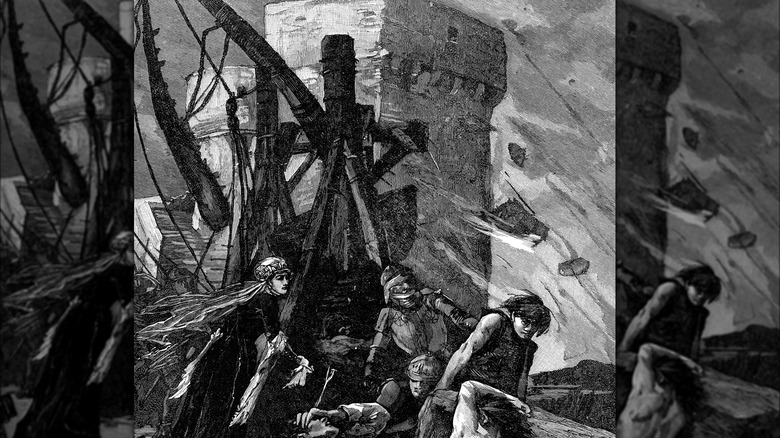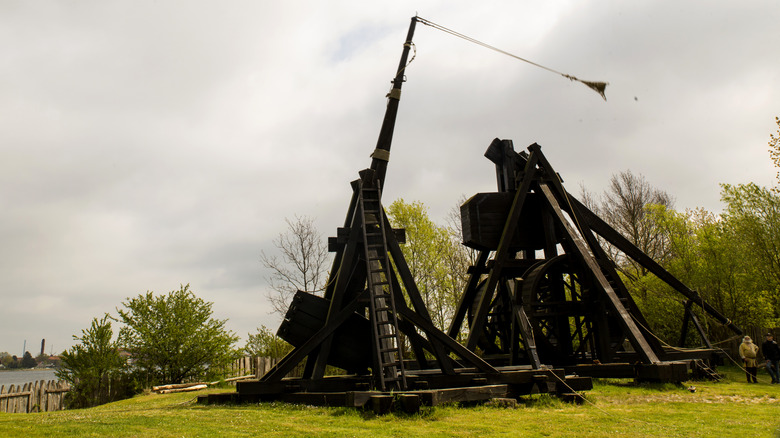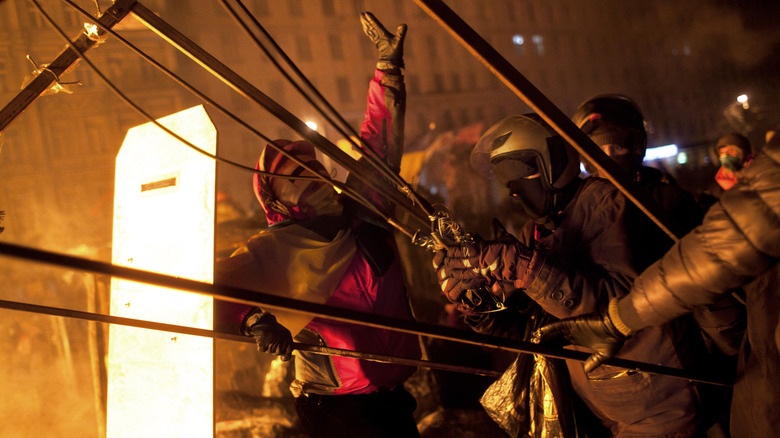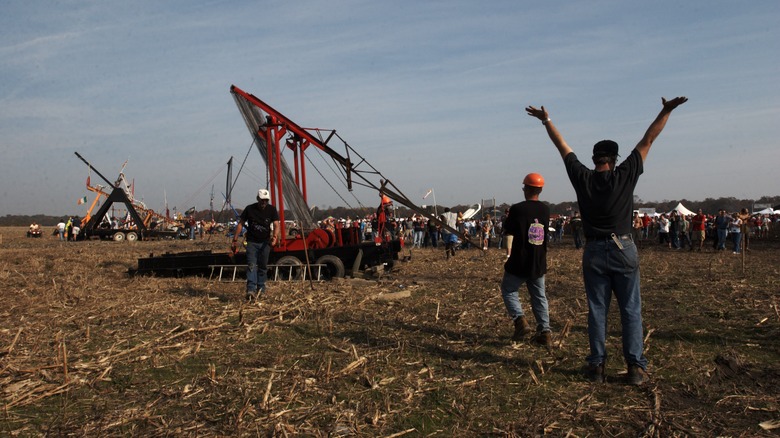History Of The Trebuchet: From Ancient China To Modern Conflict
Few weapons in the annals of military history have left as indelible a mark as the trebuchet. A masterpiece of engineering and ingenuity, this formidable siege engine has witnessed the rise and fall of empires across centuries of conflict and different continents. From its hazy origins in ancient China to its even hazier reinvention in the Middle Ages and all the way to its modern incarnations in the world of competitive pumpkin hurling, the trebuchet's journey is a testament to humanity's unyielding quest for innovation encapsulated within the framework of this awe-inspiring war machine.
The history of the trebuchet is a testament to humanity's ceaseless pursuit of more efficient ways to wage war and our enduring fascination with the art of destruction. Within the weaving historical narrative of the trebuchet lies a display of humanity's worst conflicts alongside a demonstration that not everything invented for the purposes of destruction has to stay that way.
However, the trebuchet's story is not quite a straight line as humanity has a bit of trouble with originality, with the same ideas occurring to individuals in multiple places. As such, to begin seeking an origin for the trebuchet you first have to understand what the trebuchet is and how it's different from other inventions — some of which have also sometimes been called trebuchets.
Traction vs. counterweight
The tale of the trebuchet is one of two distinct variations — the traction trebuchet and the counterweight trebuchet.
The counterweight trebuchet is almost certainly the image that pops into your head when you think of a trebuchet and defined siege warfare in the Middle Ages. Meanwhile, the traction trebuchet is the much earlier precursor of the two and can trace its origins back much further than that of the counterweight. Before delving into the history of both weapons, it's important to understand their differences and how they used force differently to accomplish similar tasks.
A traction trebuchet was a measure more crude than the weapon that would come later in that it was primarily powered by a large group of people yanking ropes to generate force enough for the arm of the weapon to propel its artillery. It isn't hard to see where this could easily go wrong, as there's plenty of room for human error. Even with the strongest human beings on the planet, a slight error in timing could result in a lackluster launch.
In contrast, the counterweight trebuchet was powered by engineering rather than raw manpower. As the name implies, the whole thing was built for use with a counterweight. Rather than having people pull ropes to propel the arm of the trebuchet, the counterweight trebuchet simplifies the whole affair by instead leaving that to a weighty box attached to a rope. However, it would take several centuries before the counterweight trebuchet launched into the history of warfare.
Ancient China and the traction trebuchet
The trebuchet's story — or at least that of the traction trebuchet – begins in ancient China. This early incarnation relied on manpower, with teams of soldiers or laborers pulling ropes to launch projectiles. Its origins remain somewhat shrouded in mystery, as historical records from this era are scarce. Early descriptions can be found in the Mozi, a document from around the fourth century BCE. Nevertheless, its introduction marked a significant step forward in the future of warfare.
Initially, it seems the traction trebuchet, sometimes called the mangonel, might not have been quite the siege weapon its successor would come to be. There were defensive functions to this trebuchet, as it is thought that they were used to launch hollowed-out logs full of burning charcoal at enemy siege arrangements. Additionally, the ability to load the traction trebuchet with some less-than-conventional objects marked it with a versatility that its counterweight cousin doesn't possess. Earliest records indicate that these original trebuchets were capable of launching projectiles up to 300 feet.
Into the second and third centuries CE, the traction trebuchet began to see far more significant siege usage during the Three Kingdoms period. Its ability to launch heavy projectiles with accuracy and force made it a formidable weapon against fortified city walls and enemy troops.
Over time, the design of the traction trebuchet evolved, but the basic idea remained the same. The simplicity behind the weapon was attractive next to the comparatively cumbersome torsion-powered weapons being used for sieges in Europe. Traction trebuchets began to appear west of China near the end of the 500s CE. However, due to their appearance in time alongside siege weapons such as the ballista or the onager, there is some confusion that comes up regarding the traction trebuchet.
Mangonel confusion
Since the traction trebuchet is occasionally referred to as the mangonel in the shorthand, there's a lot of confusion and myth that surrounds the two weapons. It's possible that if you've had some passing interest in ancient siege engines, you've likely encountered the idea that the mangonel was a torsion-powered weapon that used twisting force — torsion — to launch projectiles. It worked by wrapping a rope around a central point, typically a wooden pole, and then tightening the rope. As the rope tightened, more energy was stored in the central point. When the rope was released, the energy was released, launching the projectile.
During the Middle Ages, torsion siege engines reigned supreme with weapons like ballistas. However, lots of the weaponry of the Middle Ages was lost to time until significant rediscovery was made in the 19th century. However, rediscovery came with many errors and mischaracterizations. One of the more persistent of these errors was the idea that the mangonel was itself a torsion-powered weapon.
Although the continued use of the traction trebuchet into the Crusades wasn't a continuation of torsion siege engines, it did mark a continued usage of what can effectively be called a stone thrower. Though comparatively crude to what could be used at the time, the mangonel held its place among the artillery used in the midst of the Middle Ages. Although the traction trebuchet saw usage in the First Crusade, it would soon be overshadowed by its far more effective evolution.
Origins of the counterweight trebuchet
The counterweight trebuchet made its debut during the tumultuous Middle Ages. This innovative design utilized a counterbalance system which, when released, sent its payload hurtling through the air with remarkable force and accuracy. This technological leap revolutionized medieval warfare, with trebuchets employed in many sieges and battles. However, the exact point in time when this much more well-known version of the weapon emerged isn't entirely known. The earliest known depiction comes from 1187, but a case can be made for the weapon being developed earlier in the 11th century.
The exact mechanics of the counterweight trebuchet involved a large, heavy box that was used to propel the arm of the trebuchet in place of the traction trebuchet being propelled by people pulling the arm with ropes. As previously mentioned, the biggest issue surrounding the usage of a traction trebuchet came down to human error. No matter how well-engineered a siege engine was, any slight error amongst the team actually manning the trebuchet could result in a less-than-ideal launch.
The counterweight trebuchet had the distinct advantage of consistency at its side, with the counterweight providing a reliable force behind every launch. Although opinions vary on the exact level of destruction that the counterweight trebuchet was capable of, the impacts the weapon had are clear, as fortifications had to be updated to anticipate sieges from the very capable counterweight trebuchet.
Usage in the Crusades
The counterweight trebuchet played a pivotal role throughout the Crusades. During the 11th and 13th centuries this remarkable siege weapon, with its ability to launch heavy projectiles with precision and devastating force, became a key tool in the siege warfare tactics of both Crusader and Muslim forces.
One of the earliest documented instances of the Counterweight Trebuchet in the context of the Crusades was during the Siege of Nicaea in 1097, the First Crusade's first major battle. Crusader forces, led by leaders like Bohemond of Taranto, utilized this powerful weapon to breach the city's formidable walls, ultimately capturing Nicaea from the Seljuk Turks. The trebuchet's long range and accuracy made it instrumental in the Crusaders' conquest of various strongholds.
Throughout the subsequent Crusades, the Counterweight Trebuchet continued to be a vital asset for both sides. During the Third Crusade, Richard the Lionheart employed trebuchets in the Battle of Jaffa in 1192, aiding in the capture of the city from Saladin's forces. Saladin himself utilized similar siege engines during his campaigns to defend key territories.
The trebuchet's versatility was evident not only in its use against fortifications but also in its deployment against enemy troops. It could hurl a variety of projectiles, including massive stones, incendiary devices, and even animal carcasses to spread disease within besieged cities. The deadly technology spread throughout Europe and the Middle East, with different regions adopting and adapting the design to suit their needs. It became a symbol of medieval siege warfare prowess and was featured prominently in medieval military treatises and illustrations — one day even leading to one of the largest weapons ever made.
The counterweight trebuchet in China
The reach of the counterweight trebuchet eventually found its way back to the place where the traction trebuchet has its origins — China.
However, when the counterweight trebuchet came to China, it wasn't the Chinese who brought it there. Rather, it was the Mongols who brought the counterweight trebuchet to China when they had Muslim engineers construct these new trebuchets for them for the purpose of sieges.
Though the counterweight trebuchet did stick around within China after the Mongol Empire began to fall apart, it didn't completely replace the traction trebuchet. While the counterweight trebuchet offered many advantages, one of its only disadvantages was the comparatively cumbersome nature of it. The counterweight trebuchet had to be built at the site of the siege, unlike the lighter traction trebuchets that could more easily be moved short distances. The traction trebuchet was also a simpler construction, meaning it could deconstructed and reconstructed with shorter notice.
Later usage and decline
As the Middle Ages gave way to the Renaissance, the trebuchet remained a dominant force on the battlefield. Yet, like all formidable weapons, its prominence eventually waned with the advent of gunpowder-based artillery. Cannons and firearms replaced the trebuchet, rendering it a relic of a bygone era.
However, the story doesn't end there. There were still some recorded uses of the trebuchet for battles well into the existence of more destructive weaponry.
All the way into 1480, trebuchets were still recorded as being used at the Siege of Rhodes, which saw the Knights Hospitaller fend off a siege of Ottomans. Even more recently than that, Hernán Cortés is recorded as using trebuchets at the Siege of Tenochtitlán in 1521. However, usage in that instance was purportedly due to a lack of gunpowder and was unsuccessful. The use of the trebuchet was so unsuccessful, in fact, that apparently the Conquistadors managed to destroy their own trebuchet on the first launch.
Usage in modern conflict
While the trebuchet hasn't exactly resurged as a weapon in modern combat, it has still seen some usage in the modern world. In the midst of protests in 2014, Ukrainian protesters constructed a trebuchet that they used to launch rocks and Molotov cocktails at police officers. Though not quite within the realm of the destructive capability the weapon was once known for across Europe and Asia, it's still a verifiable modern use of the trebuchet.
However, there are more combat-oriented examples out there. In 2013, during the long-running Syrian civil war, Syrian rebels were filmed using a trebuchet to fire projectiles at government forces. While the trebuchet may have its origins in being an advanced siege engine of the Middle Ages, it has gained a new lease in combat as a simple weapon that can easily be assembled by often-times rebel forces that are outgunned by their better-equipped enemies.
Educational and amusement uses
Intriguingly, the trebuchet has found new life in the modern world, but not as an instrument of war. Instead, the trebuchet has found a new function as a spectacle of engineering prowess and entertainment. Enthusiasts and hobbyists have resurrected this ancient machine, crafting trebuchets capable of launching pumpkins in fierce competitions and recreating historic battles. It has become a symbol of innovation, showcasing the enduring fascination with the past while propelling us into the future.
The Punkin Chunkin is an annual competition involving the "chunkin" of pumpkins using medieval siege weaponry, which includes the trebuchet. While flinging pumpkins across large distances at high speeds with antiquated weapons can be a great source of entertainment, there's also a great deal that can still be learned with trebuchets.
Lesson plans exist out there for students of all ages to learn engineering concepts through the usage of trebuchets and constructing them, albeit not quite full-sized siege weapons of yore. Despite its past as an instrument of immense destruction throughout wars in the Middle Ages, the trebuchet has now situated itself as an antiquated weapon that can still be used for recreation and education.
